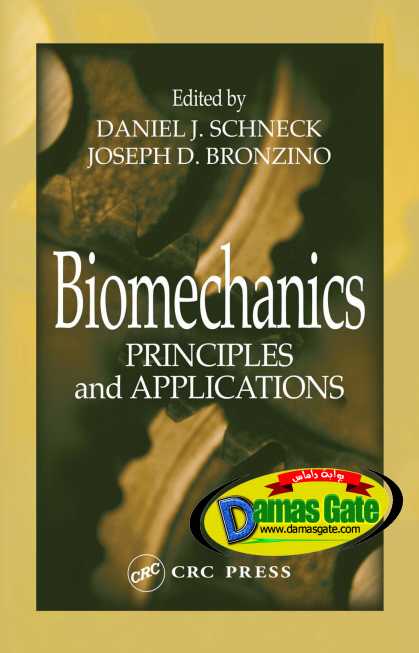Biomechanics Principles and Applications - Schneck and Bronzino

Preface
MECHANICS
IS THE ENGINEERING SCIENCE that deals with studying, defining, and mathematically
quantifying “interactions” that take place among “things” in our universe. Our ability to
perceive the physical manifestation of such interactions is embedded in the concept
and the “things” that transmit forces among themselves are classified for purposes of analysis
as being solid, fluid, or some combination of the two. The distinction between solid behavior
and fluid behavior has to do with whether or not the “thing” involved has
disturbance-response characteristics that are time rate dependent. A constant force transmitted to a solid
material will generally elicit a discrete, finite, time-independent deformation response,
whereas the same force transmitted to a will elicit a continuous, time-dependent response called flow.
In general, whether or not a given material will behavas a solid or a fluid often
depends on its thermodynamic state (i.e., its temperature, pressure, etc.).
Moreover, for a given thermodynamic state, some “things” are solid-like when deformed at certain rates
but show fluid behavior when disturbed at other rates, so they are appropriately called
which literally means “fluid-solid.” Thus a more technical definition of
mechanics is the science that deals with the action of forces on solids, fluids, and
viscoelastic materials. Bio mechanics then deals with the time and space response characteristics of
biological solids, fluids, and viscoelastic materials to imposed systems of internal and external forces. fluid viscoelastic,
Download
*

Preface
MECHANICS
IS THE ENGINEERING SCIENCE that deals with studying, defining, and mathematically
quantifying “interactions” that take place among “things” in our universe. Our ability to
perceive the physical manifestation of such interactions is embedded in the concept
and the “things” that transmit forces among themselves are classified for purposes of analysis
as being solid, fluid, or some combination of the two. The distinction between solid behavior
and fluid behavior has to do with whether or not the “thing” involved has
disturbance-response characteristics that are time rate dependent. A constant force transmitted to a solid
material will generally elicit a discrete, finite, time-independent deformation response,
whereas the same force transmitted to a will elicit a continuous, time-dependent response called flow.
In general, whether or not a given material will behavas a solid or a fluid often
depends on its thermodynamic state (i.e., its temperature, pressure, etc.).
Moreover, for a given thermodynamic state, some “things” are solid-like when deformed at certain rates
but show fluid behavior when disturbed at other rates, so they are appropriately called
which literally means “fluid-solid.” Thus a more technical definition of
mechanics is the science that deals with the action of forces on solids, fluids, and
viscoelastic materials. Bio mechanics then deals with the time and space response characteristics of
biological solids, fluids, and viscoelastic materials to imposed systems of internal and external forces. fluid viscoelastic,
Download
*